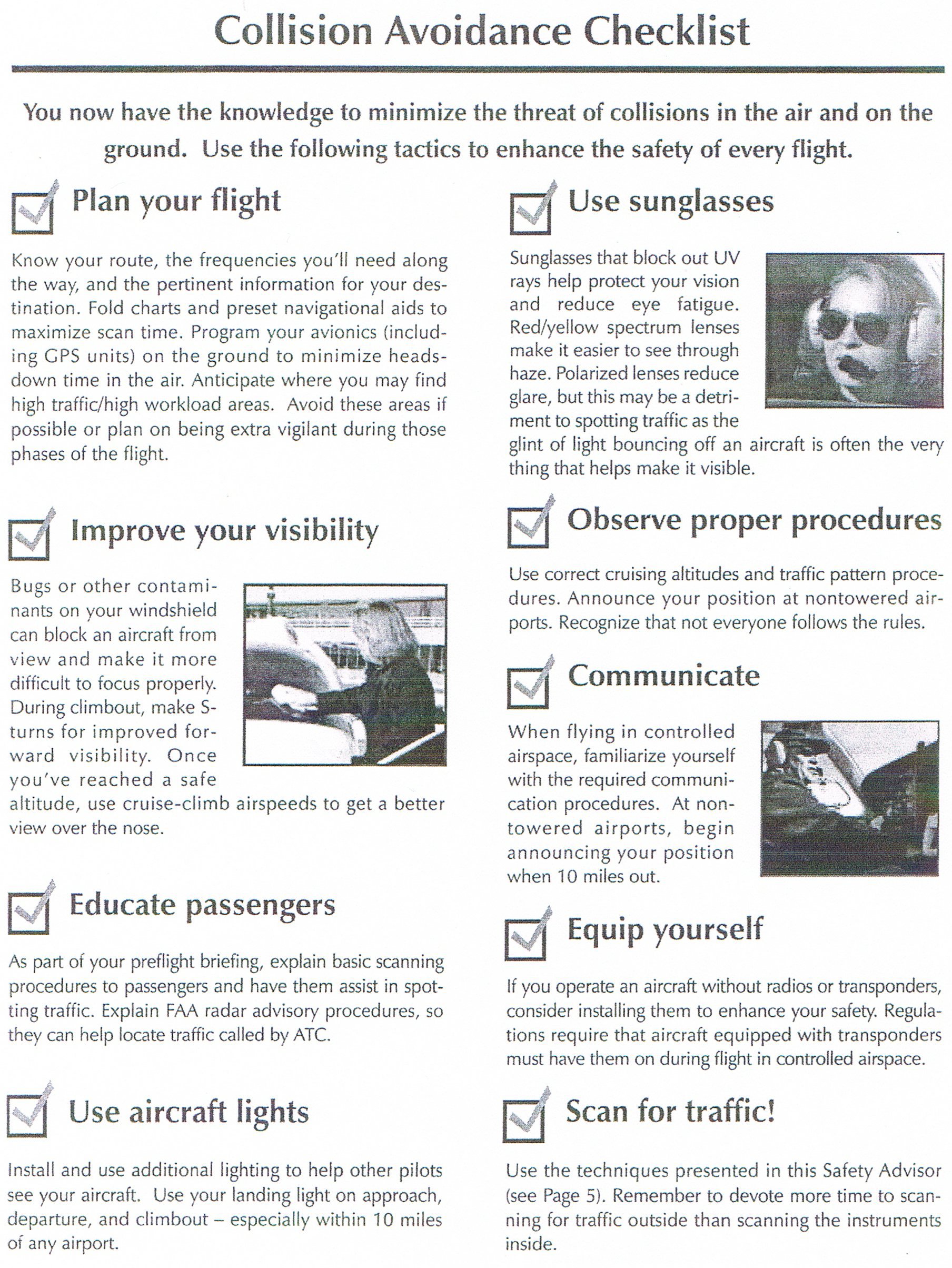Eye Movements During Daytime Collision Avoidance Scanning Should
Concentrate on relative movement detected in the peripheral vision area. In conditions of reduced visibility.

Visual Scanning Collision Avoidance
Each movement should not exceed 10 and each area should be observed for at least one second to enable detection.

. Take this quiz and test your ability to spot a potential traffic conflict and avoid a dangerous collision. A not exceed 10 degrees and view each sector at least 1 second. We have adapted a commercial eye tracking system that allows free head movement for use in a general aviation.
Eye movements during daytime collision avoidance scanning should not exceed 10 degrees and view each sector at least 1 second. Additionally the experiment results suggested that female drivers had the weaker abilities of. B a series of short regularly spaced eye movements to search each 30-degree sector.
Regularly spaced concentration on the 3- 9- and 12-oclock. Eye movements during daytime collision avoidance scanning should. C use peripheral vision by scanning small sectors and utilize off-center viewing.
Eye movements during daytime collision avoidance scanning should. The same as during daytime. A not exceed 10 degrees and view each sector at least 1 second.
Not exceed 10 degrees and view each sector at least 1 second. B be 30 degrees and view each sector at least 3 seconds. B be 30 degrees and view each sector at least 3 seconds.
Each movement should not exceed 10 and each area should be observed for at least 1 second to enable detection. Although most pilots seem to prefer horizontal. A not exceed 10 degrees and view each sector at least 1 second.
The most effective method of scanning for other aircraft for collision avoidance during nighttime hours is to use. THe segmented circle indicates that the airport traffic is-left-hand for Runway 36 and right-hand for Runway 18 PLT099 - Eye Movements during daytime collision avoidance scanning should-not exceed 10 degree and view each sector at least 1 second PLT141 - A steady green light signal directed from the control tower to an aircraft in flight is a signal that the pilot-is cleared to land. C use peripheral vision by scanning.
Visually scan the entire area for collision avoidance. Effective scanning is accomplished with a series of short regularly spaced eye movements that bring successive areas of the sky into the central visual field. The most effective method for scanning for other aircraft for collision avoidance during daylight hours is to use a series of short regularly spaced eye movements to search each 10 degree sector The most effective method of scanning for other aircraft for collision avoidance during nighttime hours is to use.
C useperipheral vision by scanning small sectors and utilizing off-center viewing. Regularly spaced concentration on the 3- 9- and 12-0clock positions. Eye movements during daytime collision avoidance scanning should not exceed 10 degrees and view each sector at least 1 second.
VFR approaches to land at night should be accomplished. Scanning patterns pilots actually use or how effective those patterns might be. Eye movements during daytime collision avoidance scanning should.
Eye movements during daytime collision avoidance scanning should. Not exceed 10 degrees and view each sector at least 1 second. Our ongoing study attempts to determine the patterns of scanning for visual traffic pilots use under varying levels of workload and traffic density.
The Aeronautical Information Manual AIM specifically encourages pilots to turn on their landing lights when operating below 10000 feet day or night and especially when operating. Peripheral vision can be useful in spotting collision risks. It was reported that about 90 of driving information is.
Peripheral vision by scanning small sectors and utilizing off-center viewing. During nighttime hours the most effective method of scanning for other aircraft is to use. Although horizontal back-and-forth eye movements seem preferred by most pilots each pilot should develop the scanning pattern that is most comfortable and then keep to it.
Each movement should not exceed 10 degrees and each area should be observed for at least 1 second to enable detection. A series of short regularly spaced eye movements to search each 10-degree sector. Although horizontal back-and-forth eye movements seem preferred by most pilots each pilot should develop a scanning pattern that is most comfortable and then adhere to it to assure optimum scanning.
A regularly spaced concentration on the 3- 9- and 12-oclock positions. Drivers eye movement patterns and how the changes in drivers eye movements further impact the collision avoidance performance. The most effective method of scanning for other aircraft for collision avoidance during daylight hours is to use.
B be 30 degrees and view each sector at least 3 seconds. Drivers had the shorter fixation duration time during the process of RLR collision avoidance and more scanning activities of searching for the RLR vehicles under the warning conditions of 45 s which indicated a high efficiency of RLR-ICAWS. Eye movements during daytime collision avoidance scanning should.
Which technique should you use to scan for traffic to the right and left during straight and level flight. Be 30 degrees and view each sector at least 3 seconds. Eye movements during daytime collision avoidance scanning should.

Visual Scanning Collision Avoidance

Visual Scanning Collision Avoidance
Human Factors Vision Scanning And Judgement Learn To Fly Blog Asa Aviation Supplies Academics Inc
No comments for "Eye Movements During Daytime Collision Avoidance Scanning Should"
Post a Comment